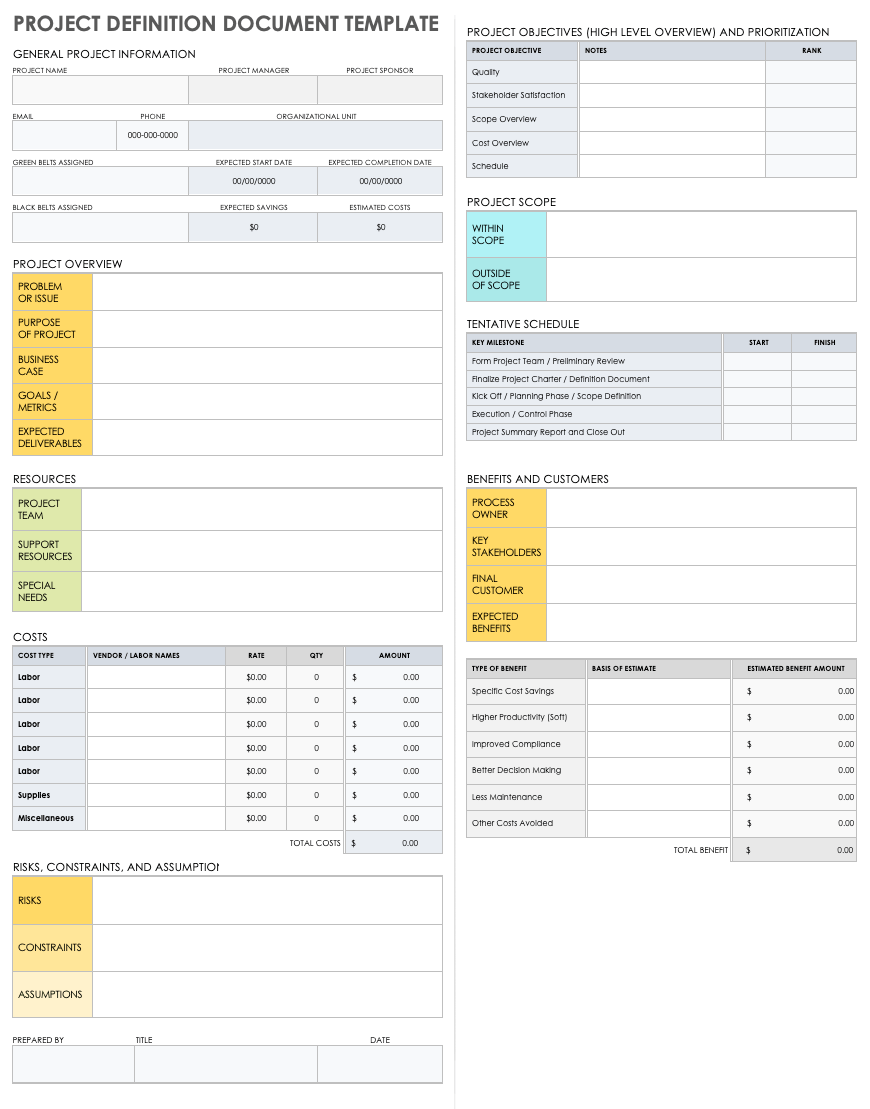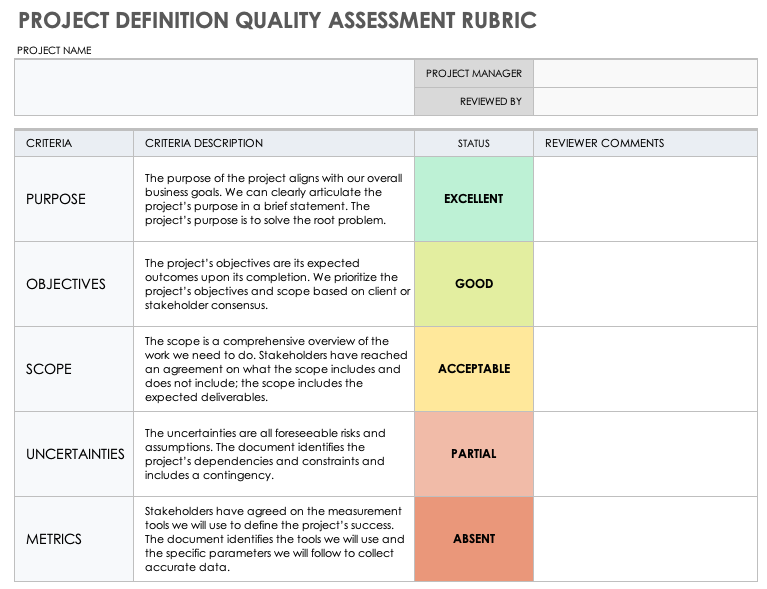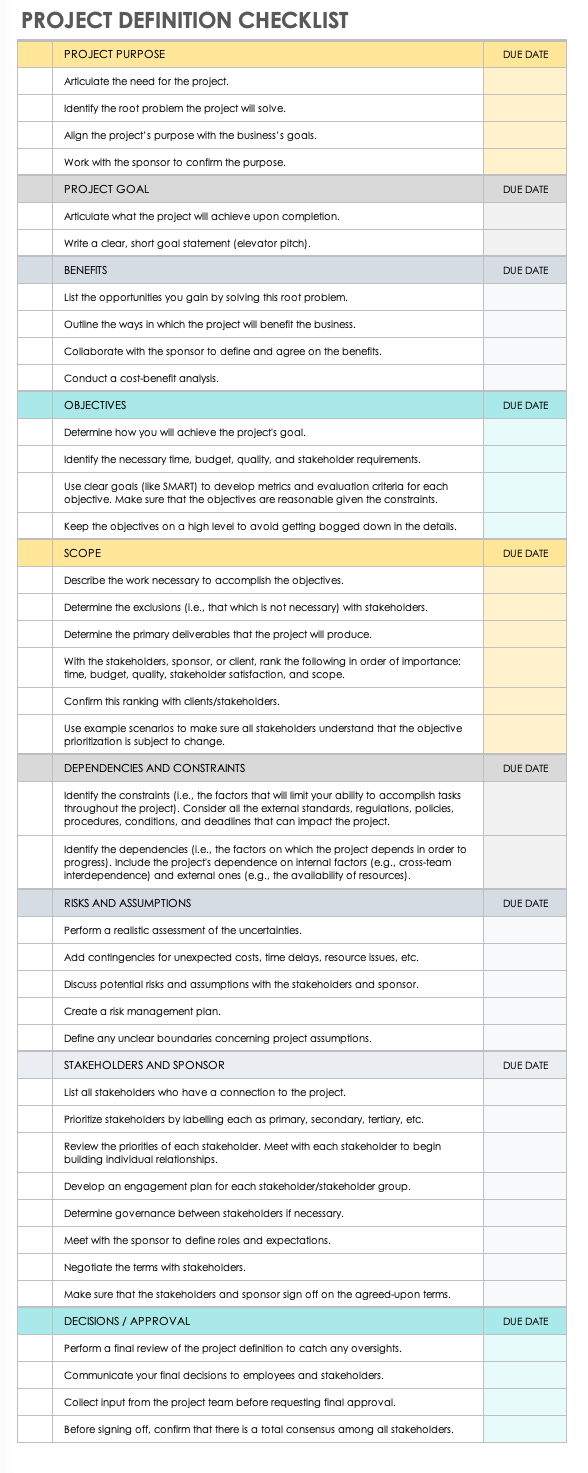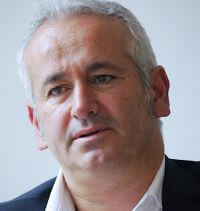What Is Project Definition?
The term project definition refers to the work a project manager, sponsor, and stakeholders undertake at the project onset to determine the goals and needs. The manager records that definition in a project charter or project definition document.
Teams perform project definition at the beginning of every project, regardless of the specific project management framework you use. The term is sometimes confused with scope definition, but the two are distinct.
Mike Clayton, the CEO and founder of OnlinePMCourses.com, notes that the confusion around project definition often occurs because there is “no fixed terminology in project management — it’s always changeable, with some more changeable than others.” The project size, school of thought, and location all influence the differentiating factors in terminology.
For example, Clayton prefers the term project definition for what PMI calls project initiation. “If your team uses PRINCE2, the term project initiation is the same stage that PMI calls project planning. On smaller projects, the project initiation and planning can merge into one.”
He also recommends that you “avoid being didactic about terminology. Sometimes project managers have been taught [terminology] one way, and then they join a different company that uses different terms.” The lack of standardization of terms can cause friction within a team if there isn’t a shared understanding of terminology or if team members get too tied to one way — the important thing is to understand the essence of the task. As Clayton continues, “As long as one of the first things you do is to define your project clearly, then you’re doing it well.”
When defining project definition and the project lifecycle phases, this article refers to the five phases of a project lifecycle from the PMBOK Guide (Project Management Body of Knowledge), created by the Project Management Institute.
Project definition occurs during the first project phase, called project initiation, and includes a high-level overview using basic information to get your project started. (Note that the definition does not contain extensive details at this point — you’ll determine specifics in the next phase, called project planning.) The goal of project definition is to guide preliminary conversations and decisions that will lead to the project’s goals and objectives. Upon approval, the team will expand the definition with more details that support its successful execution.
Read our comprehensive guide to project planning or use our project plan templates to develop the specifics of your execution tasks.
Regardless of the project management framework you use, project definition helps to create a shared understanding without expending a significant amount of effort to outline each of the following:
- People: Who is involved in the project, and what are their roles?
- Project Goals and Objectives: What are (and are not) the intended goals and output of the project?
- Purpose: Why is this project necessary to meet business goals?
By determining the above, the team and the project sponsor can make informed decisions from a shared understanding. Doing so helps you to do the following:
- Determine Project Fit: Is this project the best solution to the business problem or needs at hand? Does the project actually solve the fundamental issue? Are there other projects or directions that would be a better solution?
- Inform Business Decisions: Is this project’s return on investment (ROI) worth dedicating valuable resources?
- Align Project Objectives: Have we answered how this project meets business goals? How does this project contribute to the business?
- Onboard Project Team: Do the project’s team, stakeholders, and sponsors truly agree on the project? What compromises are necessary to specify the project’s constraints, clarify project boundaries, and avoid scope creep? What trade-offs need to occur to ensure the project meets the schedule, budget, and scope?
What Is a Good Project Definition?
A good project definition identifies the purpose of a project. A strong definition helps you manage stakeholder expectations by clearly detailing how the project solves the problem at hand, and it should prevent confusion and miscommunication throughout the project lifecycle.
Once the project manager assembles a definition outline, the next step is to ensure the team reaches consensus on the project definition. As Mike Clayton says, “Good project definition is when everyone reads the definition, understands it in the same way, and agrees to it.”
You can use the benchmarking method to maintain standards and objectives while measuring progress. Benchmarking is not a significant part of developing the objectives or goals during project definition, as this stage does not require such precision. Instead, teams use benchmarking techniques in project planning to establish performance indicators measuring the project’s performance during execution.
That said, you can use benchmarks and standards to determine the strength of your project definition. Many project managers use a project definition checklist to ensure that the project is thoroughly detailed as they assemble the project charter, especially if they manage several projects.
Once the team thoroughly specifies the project, evaluate its effectiveness and success against established criteria. No matter the industry, it is easy to place low value or feel rushed when taking the time to assess if the definition meets the standards of the project. However, if you avoid project definition, the project is vulnerable to more assumptions, scope creep, and costly risks.
Project Definition Document Template
Download Project Definition Document Template
Microsoft Word
|
Adobe PDF
| Google Docs
Use this customizable project definition document template to easily compile your project definition statement. This free template functions as an effective framework to quickly assemble your project’s overview, tentative schedule, scope, resources, costs, and customer benefits, as well as the risks, constraints, and assumptions.
Project Definition Document vs. Project Charter
A project definition document (PDD) is the umbrella term for a short document that describes a project. A project charter, project brief, and project description are types of PDDs. They all snapshot the work and resources required for a project.
There is no difference between a project charter and a project definition document — they are the same document created during the project initiation phase. Project managers may prefer one term over the other, depending on their training or their workplace, though it is best to stay consistent on the terminology within your team to avoid confusion.
Often, people confuse the project initiation document (PID), the project plan, and the scope statement with the PDD, but they are distinct. A project initiation document is a highly detailed document that you complete during project initiation. A project plan expands the outlined details in the PDD during the project planning phase, and fills in specific details and tasks. A scope statement is also a detailed document completed during the project planning that defines the budget, schedule, and boundaries for the work and resources needed.
Project Definition Document Assessment Rubric
Project Definition Quality Assessment Rubric
Microsoft Excel
| Google Sheets
Regardless of the approach you choose for developing your project definition, you should use an assessment rubric to evaluate its clarity and strength. After completing your project definition document, weigh your document against the rubric’s value criteria to determine areas of improvement. This rubric evaluates five major components of the project’s definition (purpose, objectives, scope, uncertainties, and metrics) and includes a reviewer feedback section for each criterion.
How Do You Define a Project?
To define a project, start by choosing the parameters for the project’s goals. First, determine the project objectives in relation to larger business goals, and then build consensus on the outcome of the project with stakeholders.
Your completed project definition will outline your project from start to finish without spending effort on the details. (Some project definitions may need to add more information in order to gain approval; these additional details include potential limitations, risks, and roles.) A project definition will ultimately validate the project’s primary benefit and the estimated cost to get there.
Regardless of the format or framework of your definition, the elements of a sound project definition will always include the following:
- Vision or Purpose: State why your project is necessary and how it serves a greater purpose to meet business objectives.
- Objectives: These include resulting products, goods, or services generated from the project. Project objectives can focus on tangible goals, such as a manufactured good, or on less tangible goals, such as building team efficiency or workplace culture.
- Scope: This is a high-level overview of the project’s deliverables, tasks, budget, and schedule. You can use a project scope template to help structure the overview.
- Negotiated Success Criteria: Stakeholders and the project manager must agree on how they will define project success. Specify the metrics and stick with them before you begin project work, and ensure that all stakeholders share an understanding to support future dialogue on the project’s progress.
- Exclusions: In this section, determine what is and isn’t expected to be included at project close. Stakeholders must agree to the exclusions (or project scope boundaries) to prevent scope creep.
- Additional Details: List any details needed to help communicate the project’s necessity to the approver (examples include potential risks, stakeholder priority, the sponsor, or activities required to complete the deliverables). Here, too, avoid being too detailed at this point in the process.
The project manager’s role is to determine and document the definition. However, a project manager must also manage the people in the process in order to build consensus and buy-in, especially when scoping. Although the project management lifecycle looks linear on paper, remember that some activities will naturally overlap. Therefore, the project manager works independently to prepare the tactical information and concurrently leads conversations in a highly nuanced way to get the project team working together.
Mike Clayton advises, “One of the skills a project manager must have is mediation. Your management starts with the most important stakeholders and project sponsor to learn the goals and objectives from them and to help them to articulate it. Next, figure out the scope, [which] will always be the hardest part. That’s because stakeholders want different things — it’s politics with all different sorts of views. You have to sit down with each of the stakeholders, understand their perspective, and then maybe get them in the same room to work toward an agreement.”
Project Definition Checklist
Download Project Definition Checklist
Microsoft Excel
|
Microsoft Word
|
Adobe PDF
| Google Docs | Google Sheets
Use a project definition checklist to ensure that you cover all areas as you define your project. This template includes space to highlight the project purpose, goal, objectives, scope, exclusions, dependencies, constraints, risks, issues, stakeholders, and budget, if available. You can also edit this checklist to meet the needs of your project or organization.
What Is a Project Definition Document?
A project definition document (PDD), also known as a project charter, is a two- to three-page document that outlines a project’s requirements. A project manager creates the document with stakeholder input. Project teams reference this document throughout the project lifecycle.
This initial document is essential for managing client and stakeholder expectations, since it functions as a tool to create shared understanding about project scope. This shared understanding creates transparency, which ultimately leads to greater project success.
How Do You Write a Project Definition?
To write a project definition, you need to articulate the purpose of the project. First, define the problem to determine if it makes sound business sense to proceed. Then, sketch ideas for how to deliver your solution to the problem.
After formally defining your project, you will use the document to determine if it makes sound business sense to proceed. Write your project definition using the following steps:
- Determine Which Ideas Are Suitable: Before writing the document, the project manager must approach the project with curiosity. Not all project ideas may be suitable for the business. Articulate the project’s purpose by asking what it seeks to accomplish and why.
- Estimate the Requirements: In this section, quantify the major cost, resources, and time requirements, as well as the risks the project faces.
- Identify the Project Benefits: Describe how the project positively contributes to the organizational goals, stakeholders, and clients or customers.
Antonio Nieto-Rodriguez, the former global chairman of the Project Management Institute, a PMI Fellow, professor, and the author of the Harvard Business Review Project Management Handbook, shares that it is essential to “keep project management tools simple. Most people struggle with writing a project definition because they start with the document. But really, the project definition document should not take too much time if you have spent time analyzing, discussing, and defining the key elements with your stakeholders in advance. We also need to simplify how we define projects. One of the biggest issues is focusing on the business case only. We should also spend time defining the purpose of the project —the ‘why’ are we doing the project.”
The document will help the project manager verbalize the project’s strategic alignment with the business. You can then weigh the tactical delivery of value against the time, risk, effort, expenses needed to execute the project. The most accurate PDDs are realistic about the actual time and costs. By understanding what the project is and is not, and building in room for error, you can make an informed decision with the least risk moving forward.
In the beginning, a project may also be full of ambiguity — for example, clients or sponsors may have a solution in mind that differs from the actual problem or don’t yet have enough information.
As Dawn Mahan, founder and CEO of PMOtraining, shares, “The initial definition might be, ‘I don’t have enough definition.’ If the project you’ve been tasked to lead only has three sentences, then you have to figure out what your client is looking for. Before your meeting, problem solve and think ahead of time to arrive at your client meeting prepared.”
Mahan’s patented four-step process is as follows: Form the initial definition, determine the essential problem, devise an appropriate solution, and help manage client expectations:
- Define the Problem or Opportunity as Clearly as You Can: Get to the root of the problem. A common pitfall is that your client creates a solution to their perceived problem, but their solution doesn’t truly solve the core problem. Your job is to determine if the problem they’re solving for is the correct problem. For example, your client may have called your services to install a pool. But the root of the problem is a boredom issue, and they need an entertainment space for adults and kids to solve it. Starting from the root problem opens up new potential solutions that can address the real issue.
- Identify and Force Rank the Five Delivery Objectives: After determining the root issue, outline the project’s goals and objectives using the triple constraint triangle, which refers to the project scope, budget, and schedule.
Dawn notes that the PMI’s triple constraint actually contains five delivery objectives: time, budget, scope, quality, and stakeholder satisfaction. She says that, given the choice, a client would always rank all five objectives equally. It is, therefore, the responsibility of the PM to determine a client’s priorities regarding a particular project and then to force rank those priorities for such project.
Once the project manager determines the client’s priorities, they can plan accordingly and offer relevant recommendations. By offering your client desirable solutions, you achieve two goals simultaneously: You build trust, and you reinforce your expertise as the project manager. - Generate Alternatives: Now that you know your clients’ priorities, there are a multitude of solutions. Consider the possible alternatives and get creative with developing multiple solutions.
- Determine the Solution: From the solutions you’ve generated, pick the approach that best meets the needs and the objectives. That might mean that the project manager has additional work if resources are limited — if this is the case, consider finding more funding or creating a phased approach.
Project Definition Best Practices
Successful project definition starts with identifying your project’s purpose, and then with aligning your sponsor and stakeholders to this purpose. It is the project manager’s job to move the team to a consensus, and doing so requires advanced people management skills.
It’s easy for project managers and their team to overlook the project definition, only to later find issues that could have been avoided with a clear PDD. Remind yourself of the following commonly understood best practices before the start of your next project:
- Slow down and make time for project definition.
- Be a project definition ambassador and educate your team.
- Understand the problem you’re trying to solve.
- Communicate clearly and often with your team and all relevant stakeholders, and get everyone on the team to articulate the goals to establish consensus.
- Align project goals with business goals.
- Use business cases as a reference.
Dawn Mahan shares the following: “A project manager is not just an order taker. If that were the case, there would be a lot of project disappointment because the project manager failed to ask ‘why.’ Project managers and clients or sponsors are interviewing each other — doing so builds trust and human connection and helps the project manager understand the client. This process also answers if the client truly knows what they want, which helps the project manager navigate how to work with the client.
Additionally, Neito-Rodriguez says, it’s important to engage your sponsors and stakeholders: “You need to have strong sponsorship — not just C-level-titled sponsors, but true engagement. Get buy-in from your sponsors, make sure they know their role and the expectations. Meet with your sponsor at the beginning of the project and offer to explain/define the role of the sponsor.
“Don’t assume sponsors will engage — it’s your job to drive the agenda in the early stages of the project. With a strong sponsor and clear purpose, your project may still have struggles in it, but it will be successful in the end.”
Mike Clayton provides suggestions to help hone your negotiation and influencing tactics when working with your stakeholders: “Be careful not to anchor your beliefs around the first conversation and let it take over. Avoid [doing so] by anchoring on your own beliefs and being aware of your sources of bias.”
As you work to understand your stakeholders from the beginning and make decisions, Clayton continues, “Don’t overpromise. Overpromising usually happens because the project manager focuses on one group of stakeholders. Approach the stakeholders without bias toward significant or more senior people. Your tactics can also help to move the stakeholder group to consensus by presenting a compromise to hesitant stakeholders. For example, you may say, ‘We can’t give you X, but if we can give you Y, would that help?’”
Drive Successful Project Definition with Smartsheet for Project Management
From simple task management and project planning to complex resource and portfolio management, Smartsheet helps you improve collaboration and increase work velocity -- empowering you to get more done.
The Smartsheet platform makes it easy to plan, capture, manage, and report on work from anywhere, helping your team be more effective and get more done. Report on key metrics and get real-time visibility into work as it happens with roll-up reports, dashboards, and automated workflows built to keep your team connected and informed.
When teams have clarity into the work getting done, there’s no telling how much more they can accomplish in the same amount of time. Try Smartsheet for free, today.





